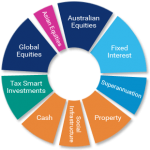{ Text Block: }
Every investor has different goals — the key to achieving them is finding the right balance.
To make the most of investing, you’ll need to have an investments plan. You should build this plan around your life goals. For example, if you want to obtain a regular flow of income from your investments, you will take a very different approach from someone who wants a large lump sum of money at a certain point in the future. You must also factor in your attitude to risk (which should vary according to your stage of life).
Every investment strategy and investment portfolio is individually tailored to suit the specific and individual needs of our clients.
As independent financial adviser, we can help you create an investments plan by considering your investable assets, your current income and outgoings, and what you want to achieve in life.
Investment Portfolio
An investment portfolio is the assets held by an investor. Our investment options are made up of different combinations of asset classes. Understanding their characteristics can help you make wise investment decisions when it comes to your super or pension.
{ Single Image: 95 }

{ Text Block: }
Asset classes are broken into two categories — defensive and growth
- Defensive assets have a lower potential rate of return over the long-term but are also generally less volatile and have less potential to lose value than growth assets.
- Growth assets have the potential to earn a higher rate of return over the long-term but are also generally more volatile than defensive assets.
{ Text Block: }
We assist to invest in the following asset classes:
{ Icon Boxes (4): }
Fixed interest & cash
Cash, short-term deposits and bonds.
Equities
Stocks and shares of ownership in a company.
Property
Investing in residential or commercial property.
Alternatives
Infrastructure, such as roads and airports, private equity investments.
{ Text Block: }
Defensive Assets:
- Government bonds (Australian and international issued)
- Corporate bonds (Australian and international issued)
- Cash and term deposits
- Hybrid bonds
- Mortgage backed securities
{ Text Block: }
Growth Assets:
- Listed Australian equities (shares)
- Listed international equities
- Property (inclusive of direct property)
- Infrastructure (toll roads, airports, etc)
- Commodities (agriculture, precious metals, energy etc)
- Alternative assets (private equity, single or multiple trading strategies)
{ Single Image: 39 }

Caption: Annuity Strategic Diversified Funds
{ Blank Space }
{ Text Block: }
The Importance of Diversification
No asset class is free from risk. Using the different characteristics of each asset class in a balanced portfolio can help to smooth fluctuations in performance and balance risk.
To reduce the risk of losing capital when investing, you should diversify your investment portfolio. This means not putting all your eggs in the one basket.
Diversification can be implemented in three distinct ways by investing:
- Across asset classes
- Across markets and regions
- Across investment management styles
{ Pullquote: }
As investment analyst, my goal has been to create a successful investment experience for our clients. As a result, we've been able to retain 95% of our clients.Steve Garcia, Investment Analyst, CFP®
{ Text Block: }
Constructing your portfolio
{ Feature List (3): }
Finding out the risk profile
Determine an appropriate spilt of growth and defensive assets after assessing the client’s need for capital preservation, risk tolerance and capital draw downs — also known as the client’s risk profile.
Allocating the assets
Consider the client’s income requirement and tax situation then select the most appropriate asset class allocation and investment style within those asset classes.
Selecting investments
Select investments using a “best of breed” professional money/fund manager approach.
{ Text Block: }
The risk profile concept
Our risk profiles and splits between growth and defensive assets are:
{ Standard Table. Columns: 3 }
Growth
Defensive
Conservative
20%
80%
Moderately conservative
40%
60%
Balanced
60%
40%
Growth
80%
20%
High Growth
100%
0%
{ Text Block: }
What our investors say:
{ Testimonials. Category ID: 22 }
{ Blank Space }
Receive investment advice from the experts.
Contact us for your complimentary first appointment.
